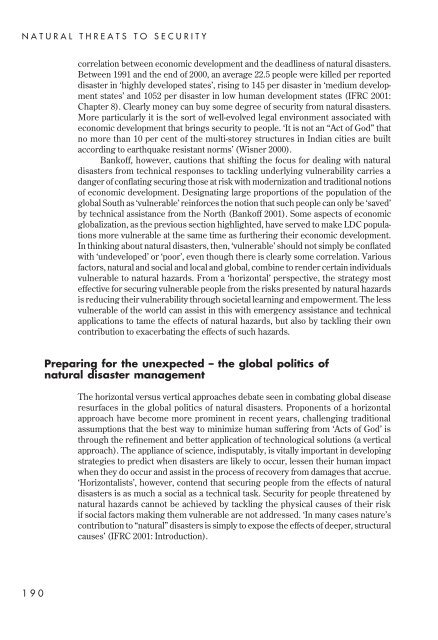Understanding global security - Peter Hough
Understanding global security - Peter Hough
Understanding global security - Peter Hough
Create successful ePaper yourself
Turn your PDF publications into a flip-book with our unique Google optimized e-Paper software.
NATURAL THREATS TO SECURITY<br />
correlation between economic development and the deadliness of natural disasters.<br />
Between 1991 and the end of 2000, an average 22.5 people were killed per reported<br />
disaster in ‘highly developed states’, rising to 145 per disaster in ‘medium development<br />
states’ and 1052 per disaster in low human development states (IFRC 2001:<br />
Chapter 8). Clearly money can buy some degree of <strong>security</strong> from natural disasters.<br />
More particularly it is the sort of well-evolved legal environment associated with<br />
economic development that brings <strong>security</strong> to people. ‘It is not an “Act of God” that<br />
no more than 10 per cent of the multi-storey structures in Indian cities are built<br />
according to earthquake resistant norms’ (Wisner 2000).<br />
Bankoff, however, cautions that shifting the focus for dealing with natural<br />
disasters from technical responses to tackling underlying vulnerability carries a<br />
danger of conflating securing those at risk with modernization and traditional notions<br />
of economic development. Designating large proportions of the population of the<br />
<strong>global</strong> South as ‘vulnerable’ reinforces the notion that such people can only be ‘saved’<br />
by technical assistance from the North (Bankoff 2001). Some aspects of economic<br />
<strong>global</strong>ization, as the previous section highlighted, have served to make LDC populations<br />
more vulnerable at the same time as furthering their economic development.<br />
In thinking about natural disasters, then, ‘vulnerable’ should not simply be conflated<br />
with ‘undeveloped’ or ‘poor’, even though there is clearly some correlation. Various<br />
factors, natural and social and local and <strong>global</strong>, combine to render certain individuals<br />
vulnerable to natural hazards. From a ‘horizontal’ perspective, the strategy most<br />
effective for securing vulnerable people from the risks presented by natural hazards<br />
is reducing their vulnerability through societal learning and empowerment. The less<br />
vulnerable of the world can assist in this with emergency assistance and technical<br />
applications to tame the effects of natural hazards, but also by tackling their own<br />
contribution to exacerbating the effects of such hazards.<br />
Preparing for the unexpected – the <strong>global</strong> politics of<br />
natural disaster management<br />
The horizontal versus vertical approaches debate seen in combating <strong>global</strong> disease<br />
resurfaces in the <strong>global</strong> politics of natural disasters. Proponents of a horizontal<br />
approach have become more prominent in recent years, challenging traditional<br />
assumptions that the best way to minimize human suffering from ‘Acts of God’ is<br />
through the refinement and better application of technological solutions (a vertical<br />
approach). The appliance of science, indisputably, is vitally important in developing<br />
strategies to predict when disasters are likely to occur, lessen their human impact<br />
when they do occur and assist in the process of recovery from damages that accrue.<br />
‘Horizontalists’, however, contend that securing people from the effects of natural<br />
disasters is as much a social as a technical task. Security for people threatened by<br />
natural hazards cannot be achieved by tackling the physical causes of their risk<br />
if social factors making them vulnerable are not addressed. ‘In many cases nature’s<br />
contribution to “natural” disasters is simply to expose the effects of deeper, structural<br />
causes’ (IFRC 2001: Introduction).<br />
190
















